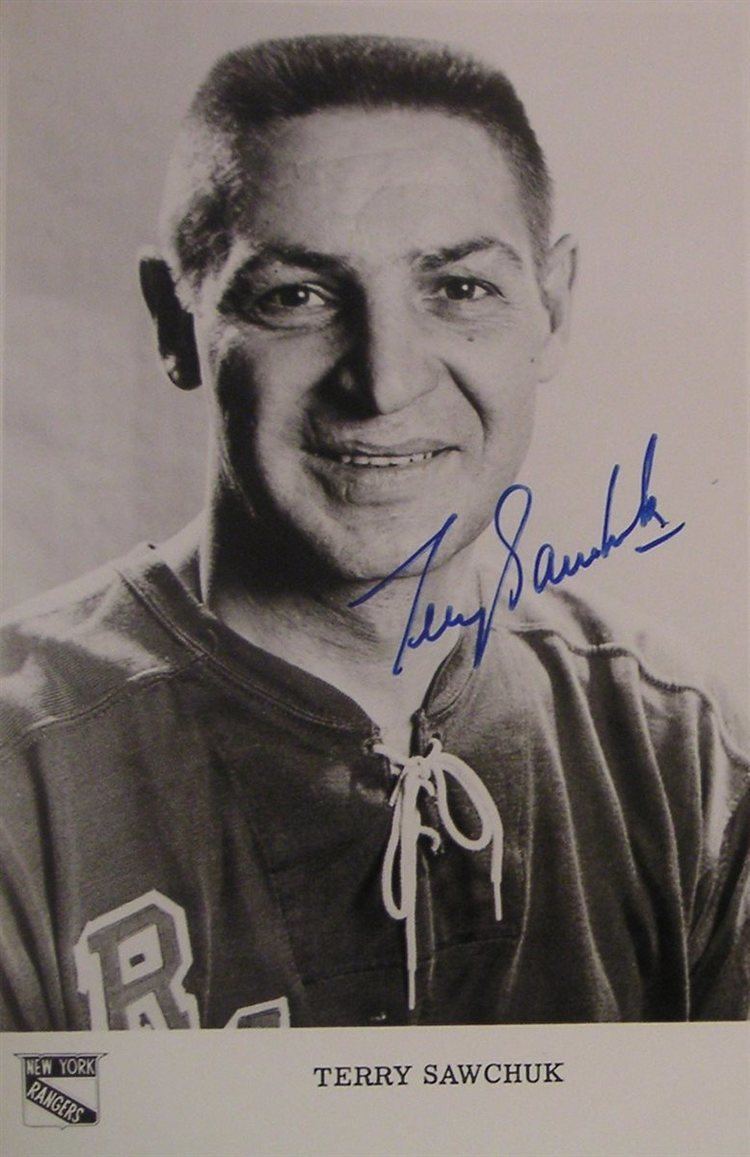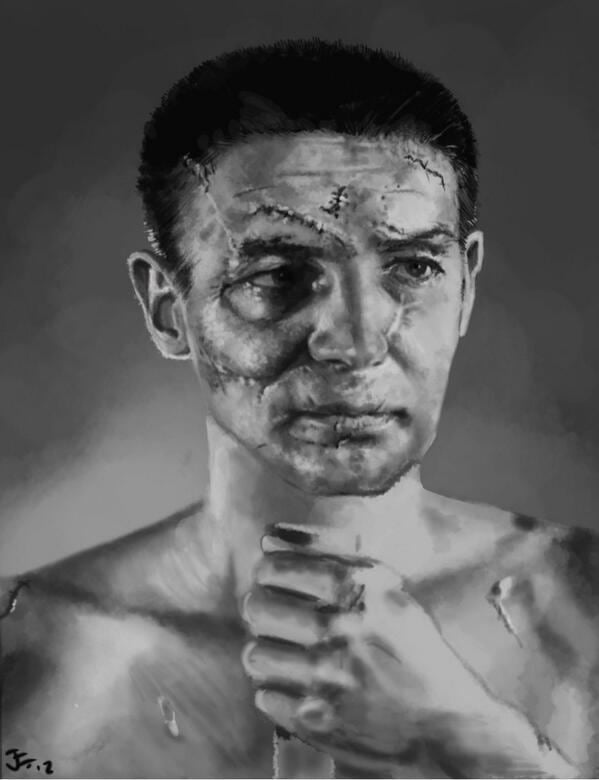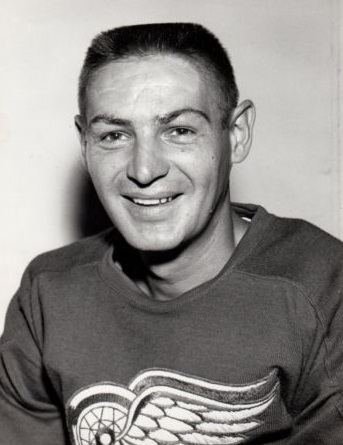Caught Left Height 1.8 m | Playing career Weight 86 kg Name Terry Sawchuk Career start 1949 | |
 | ||
Parents Louis Sawchuk, Anne Sawchuk Similar People | ||
Videojournalist terry sawchuk documentary
Terrance Gordon Sawchuk (December 28, 1929 – May 31, 1970) was a Ukrainian-Canadian professional ice hockey goaltender who played 21 seasons in the National Hockey League (NHL) for the Detroit Red Wings, Boston Bruins, Toronto Maple Leafs, Los Angeles Kings and the New York Rangers.
Contents
- Videojournalist terry sawchuk documentary
- made in winnipeg the terry sawchuk origin story one minute trailer
- Boyhood and junior career
- Detroit Red Wings
- Boston Bruins return to Detroit Toronto and Los Angeles
- New York Rangers
- Personal
- Death
- Legacy
- Awards and achievements
- Records
- References

At the time of his premature death, Sawchuk was the all-time leader among NHL goaltenders with 447 wins. Although that achievement has been surpassed by several goaltenders since, Sawchuk remains the all-time leader in wins by goaltenders who played in the Original Six era. On January 1, 2017, in a ceremony prior to the Centennial Classic, Sawchuk was part of the first group of players to be named one of the '100 Greatest NHL Players' in history.

made in winnipeg the terry sawchuk origin story one minute trailer
Boyhood and junior career

Sawchuk was born in the North End of Winnipeg and raised there until his family moved to Elmwood, both working-class, Ukrainian sections of Winnipeg, Manitoba, Canada. He was the third of four sons and one adopted daughter of Louis Sawchuk, a tinsmith who had immigrated to Canada as a boy from Galicia, Austria–Hungary (now Ukraine), and his wife Anne (nee Maslak), a homemaker. The second son died young from scarlet fever and the oldest, an aspiring hockey goaltender whom Terry idolized, died suddenly of a heart attack at age seventeen. At age twelve, Sawchuk injured his right elbow playing rugby and, not wanting to be punished by his parents, hid the injury, preventing the dislocation from properly healing. Thus, the arm was left with limited mobility and several inches shorter than the left, and bothered him for his entire athletic career. After inheriting his good friend's goalie equipment, Sawchuk began playing ice hockey in a local league and worked for a sheet-metal company installing vents over bakery ovens. His goaltending talent was so evident that at age fourteen a local scout for the Detroit Red Wings had him work out with the team, who later signed him to an amateur contract and sent him to play for their junior team in Galt, Ontario in 1946, where he also finished the eleventh grade but most likely did not graduate from high school. He excelled in many sports. He played baseball for a number of years for the Elmwood Giants first in the Manitoba Senior AA League starting in 1948, when he won the league's batting title, and then in Mandak League. He played in both the infield and the outfield.
Detroit Red Wings

The Red Wings signed Sawchuk to a professional contract in 1947, and he quickly progressed through their developmental system, winning honors as the Rookie of the Year in both the U.S. and American Hockey Leagues. Sawchuk also filled in for seven games when the Detroit goalie Harry Lumley was injured in January 1950. Sawchuk showed such promise that the Red Wings traded Lumley to the Chicago Black Hawks, though he had just led the team to the 1950 Stanley Cup. Nicknamed "Ukey" or "The Uke" by his teammates because of his Ukrainian ancestry, Sawchuk led the Red Wings to three Stanley Cups in five years, winning the Calder Trophy as the top rookie (the first to win such honors in all three professional hockey leagues) and three Vezina Trophies for the fewest goals allowed (he missed out the other two years by one goal). He was selected as an All-Star five times in his first five years in the NHL, had fifty-six shutouts, and his goals-against average (GAA) remained under 2.00. In the 1951–52 playoffs, the Red Wings swept both the Toronto Maple Leafs and the Montreal Canadiens, with Sawchuk surrendering five goals in eight games (for a 0.625 GAA), with four shutouts.

Sawchuk was ordered by Detroit general manager Jack Adams to lose weight before the 1951–52 Season, and his personality seemed to change when he dropped more than forty pounds, becoming sullen and withdrawn. He became increasingly surly with reporters and fans, preferred doing crossword puzzles to giving interviews, and struggled for years to regain the weight. Also contributing to his moodiness and self-doubt was the pressure of playing day in and day out despite repeated injuries — there were no backup goaltenders. He frequently played through pain, and during his career he had three operations on his right elbow, an appendectomy, countless cuts and bruises, a broken instep, a collapsed lung, ruptured discs in his back, and severed tendons in his hand. A standup goaltender, he adopted a crouching stance to see through the legs of skater due to screen shots and box-crowding became more prevalent to counter his agility. Years of crouching in the net caused Sawchuk to walk with a permanent stoop and resulted in lordosis (swayback), which prevented him from sleeping for more than two hours at a time. He also received approximately 400 stitches to his face (including three in his right eyeball) before finally adopting a protective facemask in 1962. In 1966, Life Magazine had a make-up artist apply stitches and scars to Sawchuk's face to demonstrate all of the injuries to his face over the years. The make-up artist did not have enough room for everything.
Boston Bruins; return to Detroit; Toronto and Los Angeles
The Red Wings traded Sawchuk to the Boston Bruins in June 1955 because they had a capable younger goaltender in the minor leagues (Glenn Hall), which devastated the self-critical goalie. During his second season with Boston, Sawchuk was diagnosed with mononucleosis, but returned to the team after only two weeks. Physically weak, playing poorly, and on the verge of a nervous breakdown and exhaustion, he announced his retirement in early 1957 and was labeled a "quitter" by team executives and several newspapers. Detroit reacquired Sawchuk by trading young forward Johnny Bucyk to Boston. After seven seasons, when they had another promising young goalie (Roger Crozier) ready for promotion from the minor leagues, Detroit left Sawchuk unprotected in the 1964 intra-league waiver draft, and he was quickly claimed by the Maple Leafs. With Sawchuk sharing goaltending duties with the forty-year-old Johnny Bower, the veteran duo won the 1964–65 Vezina Trophy and led Toronto to the 1967 Stanley Cup. In Sawchuk's last game with the Maple Leafs, he stopped 40 of 41 shots in 3-1 victory over the Montreal Canadiens in the Cup clinching game 6. Left unprotected in the June 1967 expansion draft, Sawchuk was the first player selected, taken by the Los Angeles Kings where he played one season before being traded back to Detroit.
New York Rangers
Sawchuk spent his final season with the New York Rangers, where he played sparingly, starting only six games. On February 1, 1970, in only his fourth start of the season, he recorded his 103rd and final shutout of his career by blanking the Pittsburgh Penguins 6–0. This was also his last NHL goaltender win. His last regular season start was on March 14, 1970 in a 7–4 loss to the Chicago Black Hawks. Sawchuk's last playoff start was in a 5–3 playoff quarterfinals loss to the Boston Bruins on April 9, 1970. Sawchuk appeared in his last NHL game on April 14 in the same playoff series. In game 5, after Phil Esposito had scored at 7:59 of the third period to put Boston in the lead, Rangers coach Emile Francis, in an effort to slow down the game, replaced goalie Ed Giacomin with Sawchuk. He was in the net for less than a minute before Giacomin returned and the Rangers lost the game 3–2. Boston went on to win the series 4 games to 2.
Personal
Sawchuk married Patricia Ann Bowman Morey on August 6, 1953 after a brief courtship. They had seven children, and the family suffered for many years from Sawchuk's increasing alcoholism, philandering (a Toronto girlfriend became pregnant by him in 1967), verbal and physical abuse. Morey threatened to divorce him numerous times, and finally did so in 1969.
Death
Sawchuk struggled with untreated depression, a condition that often affected his conduct. After the 1969–1970 season ended, Sawchuk and Rangers teammate Ron Stewart, both of whom had been drinking, fought over expenses for the house they rented together on Long Island, New York. Sawchuk suffered severe internal injuries during the scuffle from falling on top of Stewart's bent knee. At Long Beach Memorial Hospital, Sawchuk's gallbladder was removed and he had a second operation on his damaged and bleeding liver. The press described the incident as "horseplay," and Sawchuk told the police that he accepted full responsibility for the events.
At New York Hospital in Manhattan, another operation was performed on Sawchuk's bleeding liver. He never recovered and died shortly thereafter from a pulmonary embolism on May 31, 1970 at the age of 40. The last reporter to speak to him, a little over a week before his death, was Shirley Fischler (wife of Stan Fischler), who went to see him in the hospital as a visitor, not identifying herself as a reporter. Sawchuk told her the incident with Stewart "was just a fluke, a complete fluke accident." Fischler described him as "so pale and thin that the scars had almost disappeared from his face." A Nassau County grand jury exonerated Stewart and ruled that Sawchuk's death was accidental. Sawchuk was buried in Mount Hope Cemetery in Pontiac, Michigan.
Legacy
During his career, Sawchuk won 501 games (447 regular season and 54 playoff), while recording 115 shutouts, (103 in the regular season and 12 in the playoffs). Sawchuk set the standard for measuring goaltenders, and was publicly hailed as the "best goalie ever" by a rival general manager in 1952, during only his second season. Sawchuk finished his hockey career with 447 wins, a record that stood for thirty years, and his career record of 103 shutouts remained unsurpassed among NHL goaltenders, until Martin Brodeur bested that mark on December 21, 2009. In 1971, Sawchuk was posthumously elected to the Hockey Hall of Fame and awarded the Lester Patrick Trophy for his contribution to hockey in the United States. The Red Wings retired his number 1 in 1994. In 1997, the book Shutout: The Legend of Terry Sawchuk by sports author Brian Kendall, was published. Also, the book Sawchuk: The troubles and triumphs of the World's Greatest Goalie was published in 1998 by David Dupuis, with participation by the Sawchuk family. In 2001, he was honored with his image on a Canadian postage stamp, even though he had become a U.S. citizen in 1959. In 2008, Night Work: The Sawchuk Poems, a book of poetry about Sawchuk by Randall Maggs, was published. The Terry Sawchuk Arena in his hometown of Winnipeg is named in his honour.
